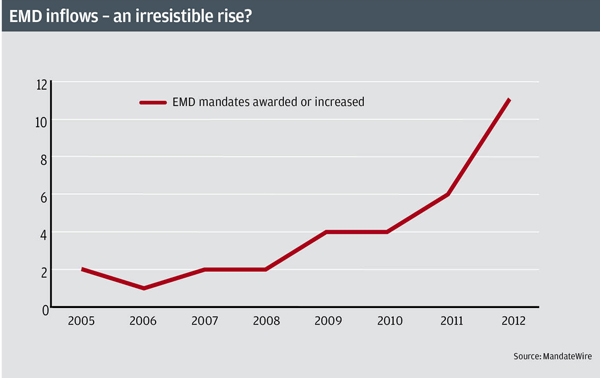Schemes that have bundled into emerging market debt at the height of its popularity face a challenging market, after investors suffer underperformance in local and hard currency debt in May.
From a relatively low base in the five years to 2010, in the following year there was a 50 per cent increase in mandates awarded or increased by UK schemes, according to data from Financial Times service MandateWire (see graph). This total almost doubled in 2012 as demand ramped up.
But this year has not been so kind to last year’s investors. The two main types of debt suffered falls in May, with JPMorgan’s global diversified hard currency debt index down 1 per cent and its local currency equivalent down 3.8 per cent.

The vast majority of the money flowing into the asset class has been long-only mandates that have not responded well to volatility as pressure comes off yields.
“We have had a huge yield compression,” says Colm McDonagh, head of the emerging markets fixed income group at asset manager Insight Investment. “That’s probably got a bit longer to play out.”
As yields correct, the market is waking up to nations and businesses that are not as sturdy as they might have first appeared.
McDonagh adds: “There are some countries and some companies that are borrowing at levels that do not reflect the underlying risk.”
Further increases in yields, the prospect of a strengthened dollar and some deterioration in EM economies could mean further drawdowns in pension funds’ EMD portfolios.
Schemes harden to EMD
Fears of worse performance were raised in Pensions Week’s manager survey back in March, where asset managers cited low developed world bond yields, overvalued mandates and inflation in developing economies as reasons for concern.
Scheme investors seem to be coming to the same conclusion. Last week, the £1.5bn Royal County of Berkshire Pension Fund shared its view that dollar-dominated EMD was “expensive”, while its local currency counterpart was “relatively fully valued” (PW 03/06/13).
The other side of the argument is that as long-term investors, pension funds need not sweat about one-off drawdowns.
“People have been and should remain comfortable with what they have seen,” said Peter Martin, head of manager research at consultancy JLT. “There can be short-term mark-to-market volatility.”
Indeed, some investors will view the drawdowns as an opportunity to increase their share in the EM growth story. “If everything has fallen in price, is that an opportunity to buy more?” Martin asks.
But managers might not be so quick to grab the opportunity. “At this stage of the credit cycle and the rate cycle… maybe you are not getting the right risk/reward [balance] at these levels,” says McDonagh.
One growing area of interest is the inflation-linked market – with nine EM countries currently issuing such fixed income assets, according to Axa Investment Managers. The latest was India, which last week issued 10-year bonds worth 10bn rupees (£115m).
These issues will not provide the exact match afforded by UK index-linked gilts, and liquidity can be a concern in these markets.
But higher yields and faster price rises would be the argument for moving some inflation-linked assets overseas.
“In recent years inflation in some of the EM markets has been higher than developed markets,” says David Dyer, senior portfolio manager at Axa IM.
The recent upshift in developed world yields will start to cut down this gap, but will need a long time to close it substantially.
The performance wobbles that have beset EMD will focus UK schemes’ minds on the volatility they are prepared to bear in this asset class, and whether they have a handle on the risks they are taking.














